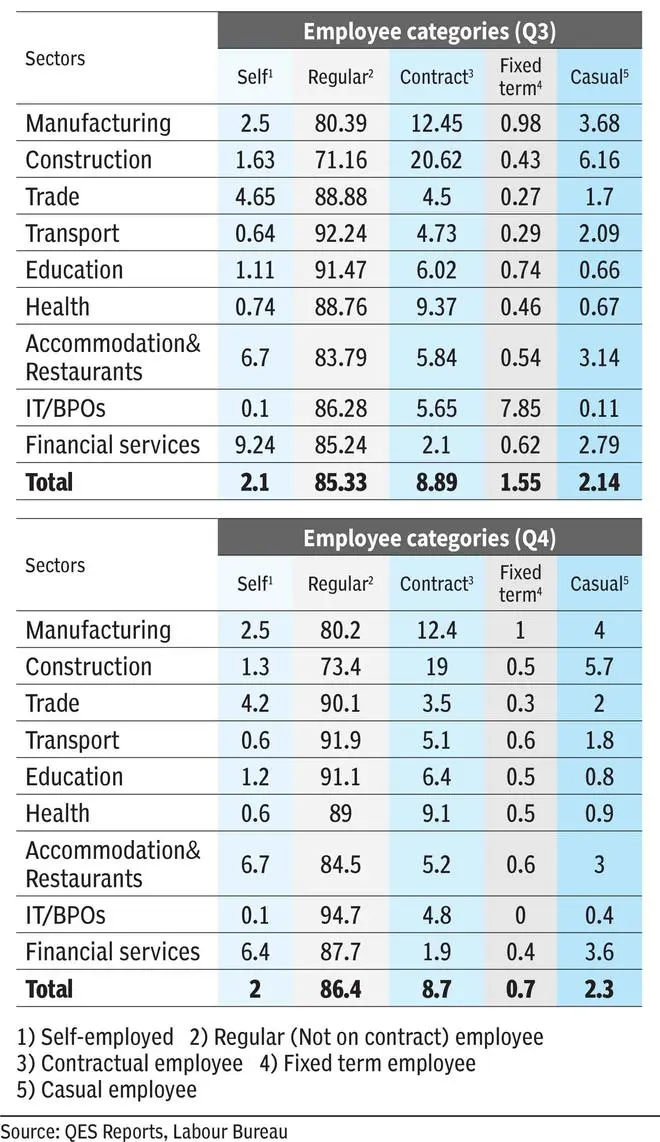The Economic Survey 2022-23 points to a recovery from the pandemic. However, the extent of this recovery is an area worth exploring. Quarterly Employment Survey (QES) of Labour Bureau sheds some light in this respect.
Generation of employment has been one of the principal concerns of development and rightly so. The Budget has emphasised employment creation through boosting demand. The 33 per cent increase in capex and tax rebates are measures that are likely to increase the volume of employment. Every Budget attempts to push employment generation through a variety of investment and other direct social welfare measures. However, employment always does not correspond to assumptions and expectations.
The QES of the Labour Bureau provides quarterly estimates about the demand side of employment and related variables of establishments (covering 10 or more workers) in formal sector. The Bureau has completed the all-India survey of establishments for four quarters (April-June 2021, July-September 2021, October-December and January-March 2022) covering nine major sectors; the report of all four quarters is also released.
Skewed growth
Estimated number of workers have shown consistent increase in the four quarters from 308.2 lakh in first quarter to 318 lakh in the fourth quarter. There has been net gain of 2.4 lakh workers in the second quarter to 3.9 lakh in the third quarter and 3.5 lakh in the fourth quarter. The deeper analysis, however shows that an increase of workers is limited to a few sectors only and most of the sectors have suffered losses of workers. So, is it a K shaped recovery of employment?
It is clearly evident that in all the sectors, barring health, education and IT/BPOs, workers employed fell in the last quarter, compared to the first quarter. There has been an overall increase to about 10 lakh workers in the fourth quarter compared to the first quarter. Financial services, in particular, saw a substantial decline (8.3 lakh workers). IT/BPOs registered significant improvement (17.6 lakh workers), health registered an increase (7.8 lakh workers), while education sector reported insignificant increase (Table-1).

Quarter to quarter comparison also indicates losses of workers across sectors, highest being in the fourth quarter compared to the first and least in the case of the third quarter compared to the second quarter.
Growth of workers over the quarters also indicates negative growth in a majority of sectors particularly Q2 over Q1 and Q4 over Q1.
In Q3 over Q2 and Q4 over Q3, the negative growth registering sectors are fewer but sectors recording positive growth is at the lower-level barring IT/BPOs (Based on Table 1).
The objective of policy ought not to be limited to mere employment generation; jobs should be efficient and equipped with quality too. In the light of recent labour reforms/labour codes, the terms of employment also become important. It is generally regarded that regular jobs are better indicator of quality of jobs compared to self-employment and casual form of employment in which neither duration of jobs nor wage are certain.
The distribution of share of employees according to terms of employment shows that share of regular employees also declined across the four quarters by more than 1 percentage point (87.5 per cent to 86.4 per cent between Q1 and Q4). Seen together with Table 1, the changes in proportion of regular, contractual and casual employees in the four quarters points to a general deterioration in working conditions.


This is perhaps correlated to the sluggish labour market.
Per CMIE estimates about 122 million people lost their jobs in the economy during the coronavirus induced lockdown. The number of employed declined from an estimated 404 million during 2019-20 to 396 million in March 2020. In April it fell further.
Clearly, performance in all the four quarters was inadequate compared to huge job losses that took place during the pandemic. Most sectors either stagnated or reported a loss in number of workers barring few sectors (IT/BPOs and health). Although the QES figure relates to the formal economy of nine major sectors only, it appears to show that job creation has not picked up in relation to total job losses in the economy.
Awasthi is with the Institute for Human Development. Shrivastav is a faculty at NILERD. Views expressed are personal





Comments
Comments have to be in English, and in full sentences. They cannot be abusive or personal. Please abide by our community guidelines for posting your comments.
We have migrated to a new commenting platform. If you are already a registered user of TheHindu Businessline and logged in, you may continue to engage with our articles. If you do not have an account please register and login to post comments. Users can access their older comments by logging into their accounts on Vuukle.